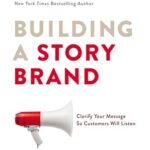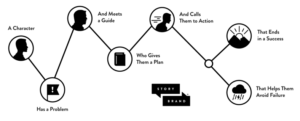 A potential lead had discussed this book. They wanted to only hire agencies who subscribed to this book’s ideals. Well, I told them it wasn’t something we could commit to, but I was intrigued. I ended up buying the book, and it’s a good read. Here’s the main points:
A potential lead had discussed this book. They wanted to only hire agencies who subscribed to this book’s ideals. Well, I told them it wasn’t something we could commit to, but I was intrigued. I ended up buying the book, and it’s a good read. Here’s the main points:
- The path of every story in brand, sales, and .. Hollywood.

- If we want to connect with our customers, be clear and direct. Have clean messages. Don’t stop blasting them with noise.
- Companies tend to sell solutions to external problems, but customers buy solutions to internal problems. e.g Carmax sells cars for people (external), but they solve the internal issues of dealing with shady used car salesman (internal).
- Story builds clarity. Story makes music out of the noise of other messages.
- Trust has two core ingredients – consistency and empathy (understanding those who understand them).
- Empathy and authority are the ingredients to be a guide in any story.
- Leaders who think of themselves as the hero may achieve temporary success but they are often remembered as the villain.
- Speak to the internal survival needs when guiding our audiences: – conserving/accumulating resources, conserving time, social needs, gaining status, innate desire to be generous, desire for meaning
- Always position your customer as the hero, and your brand as the guide.
- Good businesses close their businesses daily. Not because they don’t have a great product, but because customers haven’t figured out how their products will make their lives better.
- When presenting, think of yourself as Yoda helping guide the audience of Luke Skywalkers.
- Brands that position themselves as heroes unknowingly compete with their customers. Our customers are the hero, and we are their guide.
- As a brand, position yourself as the guide and then claim your territory of what you do.
- Always ask for a commitment from clients – This is either direct call to action (marry me) or transactional (let’s date). But always have the “direct” CTA.
- People trust those who understand them. Understand their internal dilemma (empathy).
- Always remember people want to be taken somewhere.
- Every human has the desire to transform. Your brand helps them change into the better version of themselves.
- People don’t read websites. They scan them. The fewer words you use, the more likely someone will read them.
- Brands that realize customers are human… driven to transform.. in need of help truly do more than sell products; they change people.
- Build your one-liner for elevator pitch. Set up character (customer). Define problem, create plan, and show transformation.
- Every month our top customers were being reminded that we existed. .. Our customers may not need our product today, and they might not need it tomorrow, but on the day they do need it, we want to make sure they remember who we are.
- Don’t be passive in your tone. Be active in your writing. “Jack kicked the ball.” (active) vs. “The ball was kicked by Chester.”
